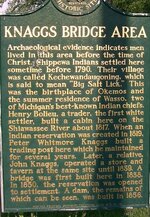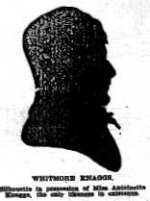Gypsy Heart
Gold Member
Buried Treasure
Shiawassee County Michigan
By William May.....1936
--------------------------------------------------------------------------------
--------------------------------------------------------------------------------
Shiawassee County had its "Captain Kid" .....one whose buried treasure proved the cause of many adventurers coming to this county, from all over the U.S.
Our Captain Kid was old Whitmore Knaggs, one of the earliest settlers in the County.
The story circulated that "Old Whit", by means of foul or other-wise, accumulated a large amount of gold. Much of it, he was supposed to have gotten away from speculators who came to buy lands. Possibly, Whit's trading post was the scene of many late night gambling partys.
But as the story goes, he had the treasure and for safe-keeping buried it along the Shiawassee River, just south of Knagg's Bridge.
The tale never started to die out, but some act or story would revive it again. Credence was added to it when an Indian girl, a daughter of Wab-ben-ness, a famous Indian of the Ket-che-wan-daug-oning reservation, told she had seen Knaggs in the act of buring and iron pot near a huge rock in the river.
"When Knaggs saw me watching him, he told me that the Gilthi-e-gan would get me if I told anyone," she later said.
A jug of strange and curious pattern was un-earthed there by Lester Roberts, who for a number of years operated a grist mill at the bridge, but whether or not his discovery was the trader's cache will probably never be known.
A man named Hadd was known as the first to search for the gold. Some twenty years after the story of the hidden treasure was first told. Hadd dug without success in several localities around the bridge.
A number of strangers appeared about the bridge in 1860 and mysteriously worked during the night. They dug up much of the land along the river and then departed, without disclosing the results of their quest.
Perhaps the same story may indirectly have been the basis for experiments conducted along the Shiawasseee's banks about half a mile from the village of Vernon, in 1935. A young mining engineer and his companions claimed to have struck a "bonanza" in the precious metal. They explained the gold was glacial deposit. However, no evidence of the gold has been produced.
The legend of buried gold never aroused any particular interest among the settlers of the vicinity, but at intervals ever since the death of Knaggs, men unknown to anyone, have appeared in the area, all of them apparently visiting on the same errand. Some sought aid from the residents in seeking the exact location of the rock widely known as "Indian Rock". But none ever found gold.
Perhaps years hence, descendants of these men who traced maps of the spring and the rock and the tree, will return to the location and work up and down the banks of the Shiawassee, seeking to claim the gold of "Old Whit".
Shiawassee County Michigan
By William May.....1936
--------------------------------------------------------------------------------
--------------------------------------------------------------------------------
Shiawassee County had its "Captain Kid" .....one whose buried treasure proved the cause of many adventurers coming to this county, from all over the U.S.
Our Captain Kid was old Whitmore Knaggs, one of the earliest settlers in the County.
The story circulated that "Old Whit", by means of foul or other-wise, accumulated a large amount of gold. Much of it, he was supposed to have gotten away from speculators who came to buy lands. Possibly, Whit's trading post was the scene of many late night gambling partys.
But as the story goes, he had the treasure and for safe-keeping buried it along the Shiawassee River, just south of Knagg's Bridge.
The tale never started to die out, but some act or story would revive it again. Credence was added to it when an Indian girl, a daughter of Wab-ben-ness, a famous Indian of the Ket-che-wan-daug-oning reservation, told she had seen Knaggs in the act of buring and iron pot near a huge rock in the river.
"When Knaggs saw me watching him, he told me that the Gilthi-e-gan would get me if I told anyone," she later said.
A jug of strange and curious pattern was un-earthed there by Lester Roberts, who for a number of years operated a grist mill at the bridge, but whether or not his discovery was the trader's cache will probably never be known.
A man named Hadd was known as the first to search for the gold. Some twenty years after the story of the hidden treasure was first told. Hadd dug without success in several localities around the bridge.
A number of strangers appeared about the bridge in 1860 and mysteriously worked during the night. They dug up much of the land along the river and then departed, without disclosing the results of their quest.
Perhaps the same story may indirectly have been the basis for experiments conducted along the Shiawasseee's banks about half a mile from the village of Vernon, in 1935. A young mining engineer and his companions claimed to have struck a "bonanza" in the precious metal. They explained the gold was glacial deposit. However, no evidence of the gold has been produced.
The legend of buried gold never aroused any particular interest among the settlers of the vicinity, but at intervals ever since the death of Knaggs, men unknown to anyone, have appeared in the area, all of them apparently visiting on the same errand. Some sought aid from the residents in seeking the exact location of the rock widely known as "Indian Rock". But none ever found gold.
Perhaps years hence, descendants of these men who traced maps of the spring and the rock and the tree, will return to the location and work up and down the banks of the Shiawassee, seeking to claim the gold of "Old Whit".









